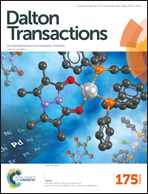Synthesis, characterization, and ligand behaviour of a new ditelluroether (C10H7)Te(CH2)4Te(C10H7) and the concurrently formed ionic [(C10H7)Te(CH2)4]Br†
Abstract
The reaction of 1-naphthyl bromide with n-butyl lithium, elemental tellurium, and 1,4-dibromobutane in THF affords both (C10H7)Te(CH2)4Te(C10H7) (1) and [(C10H7)Te(CH2)4]Br (2) in good yields. 1 is preferentially formed at low temperatures and is a rare example of a structurally characterized ditelluroether in which the tellurium atoms are bridged by a hydrocarbon chain. In the solid state, 1 shows secondary bonding Te⋯Te interactions, which connect the molecules into layers which are further linked to 3-dimensional frameworks by Te⋯H hydrogen bonds. [(C10H7)Te(CH2)4]Br (2) is formed concurrently during the synthesis of 1 and is the main product, when the reaction is carried out at room temperature. The revPBE/def2-TZVPP calculations of the reaction profiles indicate that the formation of 2 is somewhat more favourable than that of 1. Furthermore, at room temperature the activation energy for the formation of 2 is lower than that of 1. At low temperatures the activation energy of the reaction leading to 1 is lower than that to 2, which is consistent with the synthetic observations. When 1 was treated with CuBr, [Cu2(μ-Br)2{μ-(C10H7)Te(CH2)4Te(C10H7)}2] (3) was formed. It crystallizes as two polymorphs (3a) and (3b) in which both the packing and the conformation of the ditelluroether ligands are different. The reaction of 1 with HgCl2 produces [(C10H7)Te(CH2)4]2[HgCl4]·CH2Cl2 (4·CH2Cl2) and that of 1 with CuCl2 affords [(C10H7)Te(CH2)4]Cl (5). 2 and 5 are isomorphous.
![Graphical abstract: Synthesis, characterization, and ligand behaviour of a new ditelluroether (C10H7)Te(CH2)4Te(C10H7) and the concurrently formed ionic [(C10H7)Te(CH2)4]Br](/en/Image/Get?imageInfo.ImageType=GA&imageInfo.ImageIdentifier.ManuscriptID=C6DT02599D&imageInfo.ImageIdentifier.Year=2016)


 Please wait while we load your content...
Please wait while we load your content...